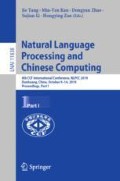Abstract
Spoken Language Understanding (SLU) is a critical component in spoken dialogue systems. It is typically composed of two tasks: intent detection (ID) and slot filling (SF). Currently, most effective models carry out these two tasks jointly and often result in better performance than separate models. However, these models usually fail to model the interaction between intent and slots and ties these two tasks only by a joint loss function. In this paper, we propose a new model based on bidirectional Transformer and introduce a padding method, enabling intent and slots to interact with each other in an effective way. A CRF layer is further added to achieve global optimization. We conduct our experiments on benchmark ATIS and Snips datasets, and results show that our model achieves state-of-the-art on both tasks.
Access this chapter
Tax calculation will be finalised at checkout
Purchases are for personal use only
References
Li, C., Li, L., Qi, J.: A self-attentive model with gate mechanism for spoken language understanding. In: EMNLP, pp. 3824–3833 (2018)
Ba, J., Kiros, R., Hinton, G.E.: Layer normalization. CoRR (2016)
Deng, L., Tur, G., He, X., Hakkani-Tur, D.: Use of kernel deep convex networks and end-to-end learning for spoken language understanding. In: 2012 IEEE Spoken Language Technology Workshop (SLT), pp. 210–215. IEEE (2012)
Deoras, A., Sarikaya, R.: Deep belief network based semantic taggers for spoken language understanding. In: Proceedings of the Annual Conference of the International Speech Communication Association, INTERSPEECH, pp. 2713–2717, January 2013
Goo, C.W., et al.: Slot-gated modeling for joint slot filling and intent prediction. In: Proceedings of the 2018 Conference of the North American Chapter of the Association for Computational Linguistics: Human Language Technologies, Volume 2 (Short Papers), vol. 2, pp. 753–757 (2018)
Haffner, P., Tur, G., Wright, J.H.: Optimizing SVMs for complex call classification. In: Proceedings of the 2003 IEEE International Conference on Acoustics, Speech, and Signal Processing (ICASSP 2003), vol. 1, p. I. IEEE (2003)
Hakkani-Tür, D., et al.: Multi-domain joint semantic frame parsing using bi-directional RNN-LSTM. In: Interspeech, pp. 715–719 (2016)
He, K., Zhang, X., Ren, S., Sun, J.: Deep residual learning for image recognition. In: 2016 IEEE Conference on Computer Vision and Pattern Recognition (CVPR), pp. 770–778 (2016)
Hemphill, C.T., Godfrey, J.J., Doddington, G.R.: The ATIS spoken language systems pilot corpus. In: Speech and Natural Language: Proceedings of a Workshop Held at Hidden Valley, Pennsylvania, 24–27 June 1990 (1990)
Huang, Z., Xu, W., Yu, K.: Bidirectional LSTM-CRF models for sequence tagging. CoRR (2015)
Kingma, D.P., Ba, J.: Adam: a method for stochastic optimization. CoRR (2015)
Kudo, T., Matsumoto, Y.: Chunking with support vector machines. In: Proceedings of the Second Meeting of the North American Chapter of the Association for Computational Linguistics on Language Technologies, pp. 1–8. Association for Computational Linguistics (2001)
Lafferty, J., McCallum, A., Pereira, F.C.N.: Conditional random fields: probabilistic models for segmenting and labeling sequence data. In: ICML 2001 Proceedings of the Eighteenth International Conference on Machine Learning, 8 June 2001, pp. 282–289 (2001)
Liu, B., Lane, I.: Attention-based recurrent neural network models for joint intent detection and slot filling. arXiv preprint arXiv:1609.01454 (2016)
Ma, S., Sun, X.: A new recurrent neural CRF for learning non-linear edge features. arXiv preprint arXiv:1611.04233 (2016)
McCallum, A., Freitag, D., Pereira, F.: Maximum entropy Markov models for information extraction and segmentation. In: ICML (2000)
Mesnil, G., et al.: Using recurrent neural networks for slot filling in spoken language understanding. IEEE/ACM Trans. Audio Speech Lang. Process. 23(3), 530–539 (2015)
Pennington, J., Socher, R., Manning, C.: Glove: global vectors for word representation. In: Proceedings of the 2014 Conference on Empirical Methods in Natural Language Processing (EMNLP), pp. 1532–1543 (2014)
Tür, G., Hakkani-Tür, D.Z., Heck, L.P., Parthasarathy, S.: Sentence simplification for spoken language understanding. In: 2011 IEEE International Conference on Acoustics, Speech and Signal Processing (ICASSP), pp. 5628–5631 (2011)
Vaswani, A., et al.: Attention is all you need. In: Advances in Neural Information Processing Systems, pp. 5998–6008 (2017)
Xu, P., Sarikaya, R.: Convolutional neural network based triangular CRF for joint intent detection and slot filling, pp. 78–83 (2013)
Yao, K., Peng, B., Zhang, Y., Yu, D., Zweig, G., Shi, Y.: Spoken language understanding using long short-term memory neural networks. In: 2014 IEEE Spoken Language Technology Workshop (SLT), pp. 189–194. IEEE (2014)
Yao, K., Zweig, G., Hwang, M.Y., Shi, Y., Yu, D.: Recurrent neural networks for language understanding. In: Interspeech, pp. 2524–2528 (2013)
Zhang, X., Ma, D., Wang, H.: Learning dialogue history for spoken language understanding. In: NLPCC (2018)
Zhang, X., Wang, H.: A joint model of intent determination and slot filling for spoken language understanding. In: IJCAI, pp. 2993–2999 (2016)
Zhao, S., Meng, R., He, D., Andi, S., Bambang, P.: Integrating Transformer and Paraphrase Rules for Sentence Simplification. arXiv preprint arXiv:1810.11193 (2018)
Zhou, L., Zhou, Y., Corso, J.J., Socher, R., Xiong, C.: End-to-end dense video captioning with masked transformer. In: Proceedings of the IEEE Conference on Computer Vision and Pattern Recognition, pp. 8739–8748 (2018)
Acknowledgments
Our work is supported by the National Key Research and Development Program of China under Grant No. 2017YFB1002101 and National Natural Science Foundation of China under Grant No. 61433015.
Author information
Authors and Affiliations
Corresponding author
Editor information
Editors and Affiliations
Rights and permissions
Copyright information
© 2019 Springer Nature Switzerland AG
About this paper
Cite this paper
Zhang, L., Wang, H. (2019). Using Bidirectional Transformer-CRF for Spoken Language Understanding. In: Tang, J., Kan, MY., Zhao, D., Li, S., Zan, H. (eds) Natural Language Processing and Chinese Computing. NLPCC 2019. Lecture Notes in Computer Science(), vol 11838. Springer, Cham. https://doi.org/10.1007/978-3-030-32233-5_11
Download citation
DOI: https://doi.org/10.1007/978-3-030-32233-5_11
Published:
Publisher Name: Springer, Cham
Print ISBN: 978-3-030-32232-8
Online ISBN: 978-3-030-32233-5
eBook Packages: Computer ScienceComputer Science (R0)


